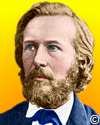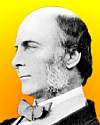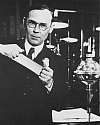
On 16 Feb 1834, Ernst Haeckel was born. Here, you can read a sample of his writing on Evolution, somewhat as road-kill left on science's relentlessly self-correcting path of progress.
Although Haeckel grasped Darwin's ideas on Evolution, Haeckel had his own concept "Ontogeny recapitulates phylogeny," meaning that he supposed any animal embryo progresses through all previous evolutionary stages as it develops. Yes, he was shown to be wrong about that, as science itself evolved with better theories.
Yet your time will be still well-spent reading this time-capsule from the 19th century, when you regard it as one of the stepping stones in the history of biology—Haeckel's interpretation of Evolution.

On 16 Feb 1822, Sir Francis Galton was born, English scientist, founder of eugenics, statistician and investigator of intellectual ability. He was a cousin and contemporary of Charles Darwin. Today's book pick is: A Life of Sir Francis Galton: From African Exploration to the Birth of Eugenics, by Nicholas Wright Gillham. Few scientists have made lasting contributions to as many fields as Francis Galton. He was an important African explorer, travel writer, and geographer. He was the meteorologist who discovered the anticyclone, the inventor of regression and correlation analysis in statistics, and the founder of the eugenics movement. Nicholas Gillham paints an engaging portrait of this Victorian polymath - a vibrant biography of a remarkable scientist as well as a superb portrait of science in the Victorian era.
It is available from Amazon, typically about New from $41.29. Used from $2.49. (As of earlier time of writing - subject to change.)
 | There is only one thing worse than coming home from the lab to a sink full of dirty dishes, and that is not going to the lab at all! |
 | The phrase 'nature and nurture' is a convenient jingle of words, for it separates under two distinct heads the innumerable elements of which personality is composed. Nature is all that a man brings with himself into the world; nurture is every influence without that affects him after his birth. |
 | The cell never acts; it reacts. |
| Before you look at today's web page, see if you can answer some of these questions about the events that happened on this day. Some of the names are very familiar. Others will likely stump you. Tickle your curiosity with these questions, then check your answers on today's web page. | |
| Births | |
 | Ernst Haeckel, born 16 Feb 1834, was a German zoologist and evolutionist who was a strong proponent of Darwinism and who proposed new notions of the evolutionary descent of man. He coined many words commonly used by biologists today, such as phylum, phylogeny, and the word used to mean “study of the interactions between organisms and their environment (home).” What is this word for “study of the home” coined by Haeckel? |
 | Sir Francis Galton, born 16 Feb 1822, was an English explorer, anthropologist, and eugenicist, known for his pioneering studies of human intelligence. He was a cousin of Charles Darwin. Galton experimentally verified that a certain human feature was unique to each individual. What is this feature? |
| Deaths | |
 | Chien-Shiung Wu (1912-1997) was a Chinese-born American physicist who provided the first experimental proof (1956) that the principle of parity conservation does not hold in certain subatomic interactions, disproving what had been thought to be a universal symmetry law of nature. Which type of interactions did She prove not to conserve parity? |
 | Henry Walter Bates (1825-1892) was an English naturalist and explorer whose demonstration of the operation of natural selection in animal mimicry), published in 1861, gave firm support to Charles Darwin's theory of evolution. What is meant by Batesian mimicry? |
| Events | |
 | On 16 Feb of a certain year, Dr. Wallace Hume Carothers, received a patent for the synthetic fiber—nylon—he had invented. It was assigned to his employer, DuPont. As early consumer use of nylon was in tooth brushes, to replace hog bristles. In which decade was this patent for nylon issued? |
 | On 16 Feb 1923, archaeologist Howard Carter opened the sealed doorway to the sepulchral chamber of a tomb in Thebes, Egypt. A group of invited visitors and officials was present, including Lord Carnarvon, the aristocratic Englishman who had funded the excavation. This was the tomb of which Egyptian? |
Fast answers for the previous newsletter for February 15: nine • Cyrus Hall McCormick • four Galilean moons: Io, Europa, Ganymede and Callisto • the interactions of subatomic particles • automobile • decade including the year 1873.
 If you enjoy this newsletter, the website, or wish to offer encouragement or ideas, please send feedback by using your mail reader Reply button.
If you enjoy this newsletter, the website, or wish to offer encouragement or ideas, please send feedback by using your mail reader Reply button. Your click on a Facebook, StumbleUpon, or other social button on the site webpages is also a welcome sign of appreciation. Thank you for using them.
© This newsletter is copyright 2020 by todayinsci.com. Please respect the Webmaster's wishes and do not put copies online of the Newsletter — or any Today in Science History webpage. (If you already have done so, please remove them. Thank you.) Offline use in education is encouraged such as a printout on a bulletin board, or projected for classroom viewing. Online, descriptive links to our pages are welcomed, as these will provide a reader with the most recent revisions, additions and/or corrections of a webpage. For any other copyright questions, please contact the Webmaster by using your mail reader Reply button.
--
If you do not want to receive any more newsletters, Unsubscribe
To update your preferences and to unsubscribe visit this link
Executive Real Estate Business Class
-
"It was like a man with wings. It wasn't like anything you'd see on TV or in a monster movie." ...
About the publisher
Search This Blog
Blog Archive
-
▼
2021
(585)
-
▼
February
(72)
- Mary Seacole | The Spitfire | George Washington
- On This Day for February 28 - Olof Palme assassina...
- On This Day for February 27 - Chile struck by eart...
- On This Day for February 26 - Napoleon's escape fr...
- On This Day for February 25 - Ousting of Marcos in...
- Demystified: How Do Penguins Tell Each Other Apart?
- On This Day for February 24 - U.S. President Andre...
- On This Day for February 23 - Alamo besieged by Sa...
- On This Day for February 22 - Cloning of Dolly, Ge...
- Your essential guide to the Tudors | LGBT+ history...
- On This Day for February 21 - Malcolm X assassinat...
- On This Day in History by OnThisDay.com: You are n...
- February 21: The 1st Romanov Tsar, the 1st Locomot...
- On This Day for February 20 - John Glenn's orbit o...
- On This Day for February 19 - Iwo Jima invaded by ...
- 🎉 Ready for 30% Off Kids' Memberships?
- On This Day for February 18 - Pluto discovered by ...
- Newsletter for Thursday 18 February.
- Demystified: Why Does Salt Melt Ice?
- On This Day for February 17 - Vietnam invaded by C...
- Newsletter for Wednesday 17 February.
- On This Day for February 16 - Power in Cuba seized...
- Newsletter for Tuesday 16 February.
- On This Day for February 15 - USS Maine destroyed,...
- Newsletter for Monday 15 February.
- February 15: The King of Persia, the Human Genome ...
- Who was Saint Valentine?
- On This Day for February 14 - Fatwa issued against...
- Newsletter for Sunday 14 February.
- February 14: Battle of Cape St Vincent, the Teleph...
- On This Day for February 13 - William and Mary cro...
- Newsletter for Saturday 13 February.
- February 13: Baghdad falls to the Mongols, the Bil...
- On This Day for February 12 - Chile's independence...
- Newsletter for Friday 12 February.
- February 12: The Qing Dynasty Ends, The Senate Acq...
- Demystified: Why Do We Say “A Pair of Pants”?
- On This Day for February 11 - St. Bernadette's fir...
- Newsletter for Thursday 11 February.
- February 11: Margaret Thatcher's Rise to Power, Ne...
- Watch ‘Tuskegee Airmen: Legacy of Courage’
- 🇺🇸💰Your Presidents' Day Exclusive Bonus!
- On This Day for February 10 - Kasparov-versus-comp...
- Newsletter for Wednesday 10 February.
- February 10: End of the French-Indian War, HMS Dre...
- All-New Tonight: 'The Food That Built America' Sne...
- On This Day for February 9 - Calcutta restored to ...
- Newsletter for Tuesday 9 February.
- February 9: Massachusetts Rebels, the Battle of Gu...
- On This Day for February 8 - Mary, Queen of Scots,...
- Newsletter for Monday 8 February.
- February 8: Mary Stuart is Decapitated, Napoleon L...
- What did Mary Tudor think of Anne Boleyn and her o...
- On This Day for February 7 - British Invasion laun...
- Newsletter for Sunday 7 February.
- February 7: The 1st English Prince of Wales, the M...
- Newsletter for Saturday 6 February.
- On This Day for February 6 - Accession of Elizabet...
- February 6: Maximilian I and Elizabeth II Ascend t...
- Black History Month: The Tuskegee Airmen Documenta...
- On This Day for February 5 - Punic Wars ended, Han...
- February 5: Congo Taken as a Personal Possession a...
- On This Day for February 4 - Yalta Conference open...
- February 4: The Chinese Song Dynasty, World's Olde...
- Serving Up an All-New Season
- On This Day for February 3 - Fifteenth Amendment t...
- February 3: The Naval Battle of Diu, Universal Suf...
- On This Day for February 2 - Ban on African Nation...
- February 2: New Amsterdam Grows Up, the US Pays Me...
- On This Day for February 1 - Space shuttle Columbi...
- Newsletter for Monday 1 February.
- February 1: Black History Month Starts and a Day o...
-
▼
February
(72)
-
Blogroll
-
About
HistoryFact










0 comments:
Post a Comment